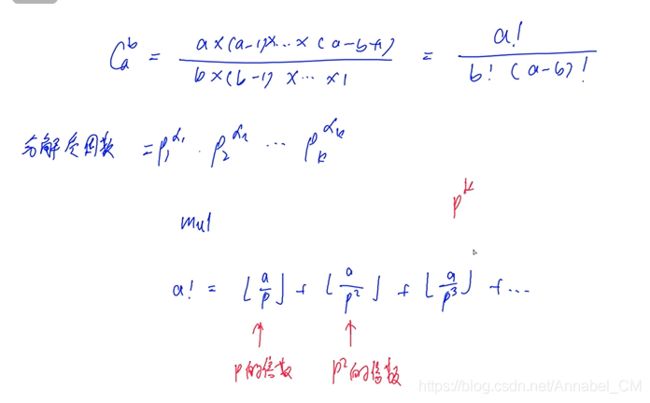求组合数——数学知识(c++)
文章目录
-
- 一、递推(杨辉三角)
- 二、乘法逆元
- 三、卢卡斯定理
- 四、 质因数分解
- 总结
组合数的公式:
一、递推(杨辉三角)
AcWing 885. 求组合数 I
给定n组询问,每组询问给定两个整数a,b,请你输出Cba mod (109+7)的值。
输入格式
第一行包含整数n。
接下来n行,每行包含一组a和b。
输出格式
共n行,每行输出一个询问的解。
数据范围
1≤n≤10000,
1≤b≤a≤2000
输入样例:
3
3 1
5 3
2 2
输出样例:
3
10
1
#include 二、乘法逆元
AcWing 886. 求组合数 II
给定n组询问,每组询问给定两个整数a,b,请你输出Cba mod (109+7)的值。
输入格式
第一行包含整数n。
接下来n行,每行包含一组a和b。
输出格式
共n行,每行输出一个询问的解。
数据范围
1≤n≤10000,
1≤b≤a≤105
输入样例:
3
3 1
5 3
2 2
输出样例:
3
10
1
#include 三、卢卡斯定理
AcWing 887. 求组合数 III
给定n组询问,每组询问给定三个整数a,b,p,其中p是质数,请你输出Cba mod p的值。
输入格式
第一行包含整数n。
接下来n行,每行包含一组a,b,p。
输出格式
共n行,每行输出一个询问的解。
数据范围
1≤n≤20,
1≤b≤a≤1018,
1≤p≤105,
输入样例:
3
5 3 7
3 1 5
6 4 13
输出样例:
3
3
2
#include 四、 质因数分解
乘法逆元只能处理模数为大质数的情况,卢卡斯定理只能处理模数为质数的情况,那有没有一种方法能处理模数不是质数的情况呢?显然是有的。而且不取模也是可以的。
我们可以把组合数中要乘或除的每一个数分解质因数,再把分母的质因数减掉,最后把剩下的质因数乘起来,边乘边模p就行了。
那如何分解质因数呢?可以用欧拉筛把每个数的最小质因数求出来,把i的最小质因数的编号保存在min_prime[i]里。
具体看代码吧。
AcWing 888. 求组合数 IV
输入a,b,求Cba的值。
注意结果可能很大,需要使用高精度计算。
输入格式
共一行,包含两个整数a和b。
输出格式
共一行,输出Cba的值。
数据范围
1≤b≤a≤5000
输入样例:
5 3
输出样例:
10
#include 总结
写了这么多种算法,每种算法都有其优点与局限性。递推写起来快,思维简单,但时间复杂度高。乘法逆元用得比较普遍,因为一般都是模一个大质数,复杂度也几乎是线性的。卢卡斯定理只会在特定的题目里做到,但其实编程复杂度并不高,就是在乘法逆元的基础上加几句话。质因数分解的适用性最广,编程复杂度也最高,这就是完美的代价吧。






